Topic: Earth Surface Features
Earth Surface Features
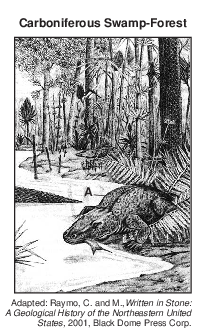
The Acadian Mountains were formed as a result of the collision between North America and
(1) Avalon
(2) South America
(3) Pangaea
(4) Queenston Delta
The surface bedrock of Mt. Marcy, New York, is composed primarily of which rock?
(1) anorthosite
(2) marble
(3) quartzite
(4) hornfels
New York State bedrock of which age contains salt, gypsum, and hematite?
(1) Cambrian
(2) Devonian
(3) Mississippian
(4) Silurian
The block diagram below represents the formation of an island arc near a plate boundary.

An island arc is located near the boundary between which two tectonic plates?
(1) Antarctic Plate and Indian–Australian Plate
(2) Philippine Plate and Eurasian Plate
(3) African Plate and North American Plate
(4) Scotia Plate and South American Plate
Which two New York State locations have surface bedrock of similar ages?
(1) Mt. Marcy and Slide Mt.
(2) Buffalo and Rochester
(3) Old Forge and Niagara Falls
(4) Watertown and Albany
Crustal Activity at Mid-Ocean Ridges
Mid-ocean ridges are found at one type of tectonic plate boundary. These ridges consist of extensive underwater mountain ranges split by rift valleys. The rift valleys mark places where two crustal plates are pulling apart, widening the ocean basins, and allowing magma from the asthenosphere to move upward. In some cases, mid-ocean ridges have migrated toward nearby mantle hot spots. This explains why mid-ocean ridges and mantle hot spots are found together at several locations.
Which mantle hot spot is located closest to a mid-ocean ridge?
(1) Canary Islands
(2) Easter Island
(3) Hawaii
(4) Tasman
The formation of the Canary Islands was primarily caused by their location near a
(1) subduction zone
(2) mantle hot spot
(3) divergent boundary
(4) transform fault
The block diagram below represents two parallel mountain ranges.

Which two geologic processes most likely created this landscape region?
(1) volcanism, followed by metamorphism
(2) faulting, followed by deposition
(3) folding, followed by erosion
(4) glaciation, followed by rifting
Island Arcs
Island arcs are long, curved chains of oceanic islands associated with seismic activity and mountain-building processes at certain plate boundaries. They occur where oceanic tectonic plates collide. Along one side of these island arcs, there is usually a long, narrow deep-sea trench.
At island arcs, the denser plate is subducted and is forced into the partially molten mantle under the less dense plate. The islands are composed of the extrusive igneous rocks basalt and andesite. The basalt originates most likely from the plastic mantle. The andesite originates most likely from the melting of parts of the descending plate and sediments that had accumulated on its surface.
An island arc is found along the
(1) East Pacific Ridge
(2) Iceland Hot Spot
(3) Aleutian Trench
(4) Peru-Chile Trench
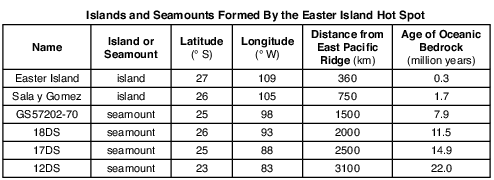
On the map in the image provided, plot with Xs the locations of the six islands and seamounts formed by the Easter Island Hot Spot. [1]

Allow 1 credit if the centers of all six Xs are within or touch the clear boxes shown below.. Note: Allow credit if a symbol other than an X is used.
• It is recommended that an overlay of the same scale as the student answer sheet be used to ensure reliability in rating.
• 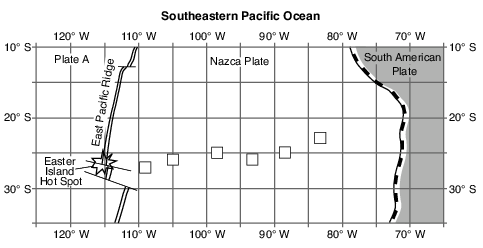
On the cross section in the image provided, place two arrows, one on each side of fault AB, to show the relative movement of the rock units on each side of the fault. [1]
Allow 1 credit for the correct placement of both arrows as shown below.
• Example of a 2-credit response for questions 83 and 84:
• 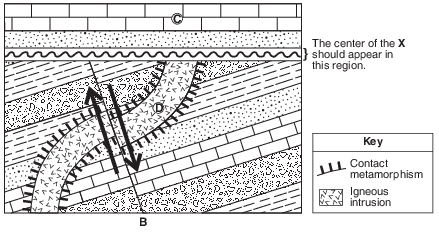

Explain why the Two Peaks sandstone is not a continuous layer. [1]
Allow 1 credit. Acceptable responses include, but are not limited to:
• — Faulting displaced the sandstone layer.
• — Two Peaks sandstone was broken by faults in two locations.
• — faulting
Write the letter of the oldest rock unit in the cross section. [1]
Allow 1 credit for F.
Complete the diagram in the image provided by shading the pattern of normal polarity on the west side of the ridge center. Assume the rate of plate movement was constant on both sides of the ridge center. Your answer must show the correct width and placement of each normal polarity section. [1]
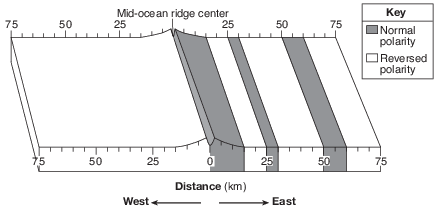
Allow 1 credit if the width and placement of the shading have been correctly indicated on either the surface and/or the side view.
• Example of a 1-credit response:
• 
Identify one feature in the mantle beneath Iceland that causes larger amounts of magma formation in Iceland than at most other locations along the rest of the Mid-Atlantic Ridge rift. [1]
Allow 1 credit. Acceptable responses include, but are not limited to:
• — Iceland is over a mantle hot spot.
• — A mantle plume rises in the region.
• — Iceland Hot Spot
• Note: Do not allow credit for “diverging plate,” “convection currents,” or “rising magma” because
• they occur mostly along the rest of the Mid-Atlantic Ridge rift.
